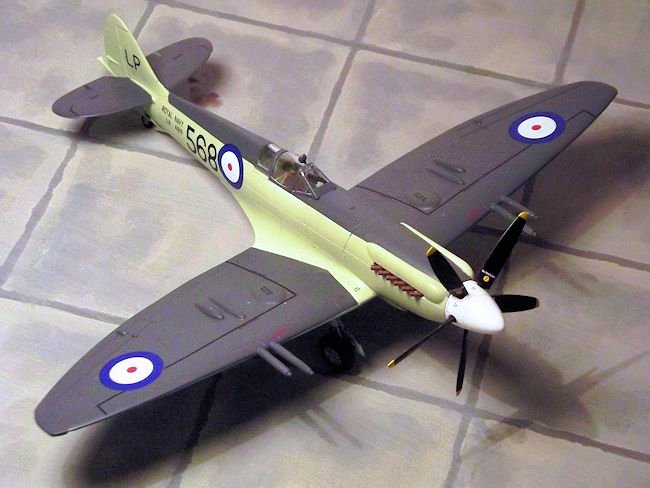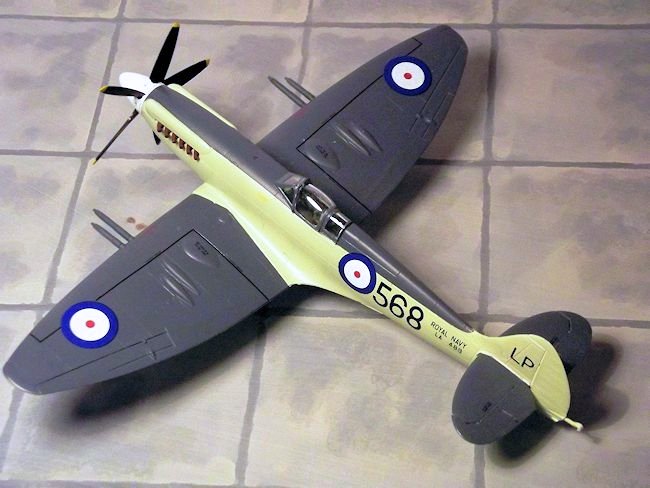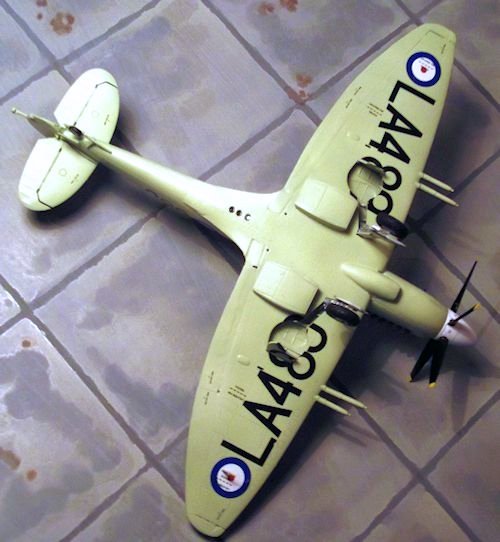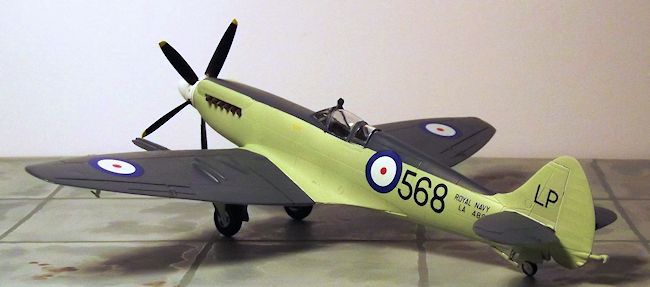
Airfix 1/48 Seafire 45
| KIT #: | ? |
| PRICE: | $ |
| DECALS: | Spares |
| REVIEWER: | Frank Reynolds |
| NOTES: |
A challenging kitbash, using Airfix Spitfire PR.19 and Airfix
Seafire 46/47 |

| HISTORY |
As
World War 2 drew to a close the pace of development of the Supermarine Spitfire
and Seafire series showed no signs of abating. A series of “Super Spitfires” was
planned, using a modified wing that did away with the characteristically
graceful elliptical plan form, in favour of a more blunt wing tip, all in the
interests of aerodynamic refinement. The wing had an uprated armament of four
20mm cannon and a strengthened, wider, undercarriage with separate doors over
the wheel wells. Enlarged under wing radiators and oil coolers were provided.
A
distinctive five-bladed propeller was fitted to a 2,045hp Griffon
 61
engine. This resulted in the Spitfire 21, an aircraft that had progressively
evolved from the original Spitfire in such a radical way that there was a
serious proposal to name it the Supermarine Victor, since it could be considered
a new type. However it was late 1944 by the time that this upgraded type began
to enter service and the end of the line was in sight, with newer more powerful
fighter types coming into service and the advent of jet propulsion. The result
was that the later, more developed versions of the Spitfire were produced in
relatively small numbers.
61
engine. This resulted in the Spitfire 21, an aircraft that had progressively
evolved from the original Spitfire in such a radical way that there was a
serious proposal to name it the Supermarine Victor, since it could be considered
a new type. However it was late 1944 by the time that this upgraded type began
to enter service and the end of the line was in sight, with newer more powerful
fighter types coming into service and the advent of jet propulsion. The result
was that the later, more developed versions of the Spitfire were produced in
relatively small numbers.
The
Royal Navy maintained an interest in Spitfire development throughout World War 2
and from late 1943 it was planned that for almost every Spitfire fighter type,
there would a Seafire equivalent. However it transpired the Navy’s Griffon
engine Seafires would be built in even smaller batches. The Griffon engine was
enclosed in an enlarged and lengthened nose cowl, which further restricted
forward view in an aircraft type that was already difficult to deck land.
The
Seafire 45 is a navalised Spitfire 21, built as an interim type with minimal
alterations. It lacked folding wings, but was capable of deck landing by virtue
of a stinger type arrester hook. The 50 or so built were delivered from mid-1945
and were distributed between three land based training squadrons, never seeing
front line carrier based service.
| THE KIT |

I find it easier to build a kitbash of this type by treating the sub -assemblies as separate models for as long as possible before the major units are joined, even to the extent of keeping the groups of components in separate boxes on a shelf next to the workbench.
| CONSTRUCTION |
For
the fuselage, I followed the sequence set out in the Airfix PR.19 instructions.
Commencing with the cockpit interior, the fuselage was assembled and allowed to
set hard over a couple of days. When building the interior I used the standard
kit parts but added a gun sight from the spares box and omitted the
 redundant
bulkheads and equipment from the camera bay. Seat belts are simply made from
masking tape. .The interior was painted in Xtarcrylix Interior green with the
upper side walls of the cockpit picked out in night black. An instrument panel
decal came from the Seafire 47 sheet.
redundant
bulkheads and equipment from the camera bay. Seat belts are simply made from
masking tape. .The interior was painted in Xtarcrylix Interior green with the
upper side walls of the cockpit picked out in night black. An instrument panel
decal came from the Seafire 47 sheet.
Next
came a visit to the Seafire 47 box, from where I plundered a wing and
undercarriage assembly, based on the non-folding wing parts. This is a
relatively simple structure of a one piece full span lower section and separate
right and left upper panels.
Once
everything had set over a couple of days the one piece full span lower wing was
offered up to the fuselage halves to check the fit and the upper wing panels
taped in place. Some adjustment was necessary since the wing to fuselage
fairings on the PR.19 fuselage were shorter in chord by about 1mm so the
trailing edge of the lower wing was shaved back to fit. Crude, probably not
absolutely true to scale, but effective. The upper wing panels similarly needed
to be reduced by about 1mm at the root to obtain a comfortable fit.
Small strips of
plastic card were fixed into the wing/fuselage joint to pad out small gaps. The
lower wing was then glued in place and left to dry overnight.
.The
only dramatic mismatch of parts was a large gap where the under fuselage cameras
would have been on the Mk.19. This could be filled in with scrap plastic and
filler – I chose to use an offcut from the rear of the PR.19 lower wing,
adjusted with a sliver of plastic card and some careful sanding and carving. The
under wing radiators were blended into the lower wing, requiring a little
fettling along the flanges at the base of the side walls that fair into the wing
lower surfaces. I
then added the underwing flaps, trimmed to fit the
modified trailing edge and the wing tip lights.
The
PR.19 lower nose section and carb air intake could be added unmodified, but a
little filler was required to blend the intake assembly into the wing leading
edge.
The
main tail assembly was all from unmodified PR.19 components, although the rudder
was cut back to accommodate a sting type arrester hook taken directly from the
‘47. Spitfire
IX kit and fitted reasonably neatly
onto the Airfix underpinnings with a little trimming.
Spitfire
IX kit and fitted reasonably neatly
onto the Airfix underpinnings with a little trimming.
Left
to settle for 24 hours and with transparencies masked, the whole airframe was
sprayed with auto primer from a rattle can to show up any dings and scratches
which were treated with Revell Plasto filler and the primer then touched in.
| COLORS & MARKINGS |

Decals were a challenge and certainly taxed the resources of my decal dungeon
and spares box. Although Seafires are increasingly covered by aftermarket
producers, there are no Mk.45 sheets available to my knowledge. Even generic
sheets are a problem since the Royal Navy used a different font and size from
that of the more commonly available RAF codes and serials. .However, using the
Freeman colour notes, I concocted the various black serials and codes from an
Aviaeology sheet of
serials no AOD48CO5; Colorado Decals serials sheet 48.48;
Xtradecal Sheet
X48044. Roundels
and small serials came from Kits-World sheet KW148092 “Post War Supermarine
Seafires”, which does not cover the Mark 45 as such but
 provides
useful common decals. The massive underwing serial numbers came from the same
Kits-World sheet and with letters “L” and “A” bodged together from cut up
sections the letters “I” and “V” on the same sheet. Airframe stencils came from
the standard Airfix decal sheet.
It took me about as long to sort out all the decals from
different sources as to make the whole model. The challenge continued since the
under wing serials have to be cut and sliced to fit around the wheel wells and
undercarriage doors. Decalling took place over three days, allowing my plenty of
time for breaks to catch my breath.
provides
useful common decals. The massive underwing serial numbers came from the same
Kits-World sheet and with letters “L” and “A” bodged together from cut up
sections the letters “I” and “V” on the same sheet. Airframe stencils came from
the standard Airfix decal sheet.
It took me about as long to sort out all the decals from
different sources as to make the whole model. The challenge continued since the
under wing serials have to be cut and sliced to fit around the wheel wells and
undercarriage doors. Decalling took place over three days, allowing my plenty of
time for breaks to catch my breath.
| CONCLUSIONS |
The
Seafire 45 is a challenge, but a satisfying one. I have previously tried a
similar cross-kitting exercise to produce a Seafire XV from a Spitfire XII and a
Seafire XVII. The Mk.45 project was a little more complicated since a certain
amount of filling and scribing is necessary and careful work to blend in the
rear lower section of the wing to the fuselage.
The cost is
£19-99 for the Seafire 46/47, £18-99 for the Spitfire PR.19, and about £30-00
for the decals, although there are plenty of spares left over for future
projects. Overall, I am reasonably satisfied with the result and the cost is not
too bad compared with the amount of money that is charged for some short-run
kits.
| REFERENCES |
Profiles 5, Supermarine Seafire Mk.1b – Mk.47, by Jon Freeman. The Aviation
Workshop Publications Ltd.
Spitfire, the History by Eric B. Morgan and Edward Shacklady, Key Publishing,
2000
September 2014
Copyright ModelingMadness.com. All rights reserved. No reproduction in any form without express permission from the editor.
If you would like your product reviewed fairly and fairly quickly, please contact the editor or see other details in the
Note to
Contributors.